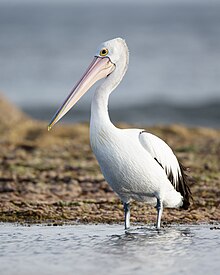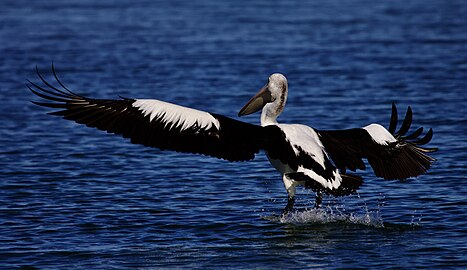Australian pelican
| Australian pelican | |
|---|---|

| |
| Scientific classification | |
| Domain: | Eukaryota |
| Kingdom: | Animalia |
| Phylum: | Chordata |
| Class: | Aves |
| Order: | Pelecaniformes |
| Family: | Pelecanidae |
| Genus: | Pelecanus |
| Species: | P. conspicillatus
|
| Binomial name | |
| Pelecanus conspicillatus Temminck, 1824
| |

| |
| blue : nonbreeding green : year-round | |
The Australian pelican (Pelecanus conspicillatus) is a large waterbird in the family Pelecanidae, widespread on the inland and coastal waters of Australia and New Guinea, also in Fiji, parts of Indonesia and as a vagrant in New Zealand. It is a predominantly white bird with black wings and a pink bill. It has been recorded as having the longest bill of any living bird. It mainly eats fish, but will also consume birds and scavenge for scraps if the opportunity arises.
Taxonomy
The Australian pelican was first described by Dutch naturalist Coenraad Jacob Temminck in 1824. Its specific epithet is derived from the Latin verb conspicere, meaning 'to behold', and refers to the 'spectacled' appearance created by its conspicuous eye markings.[2]
Description
The Australian pelican is medium-sized by pelican standards, with a wingspan of 2.3 to 2.6 m (7.5 to 8.5 ft). Weight can range from 4 to 13 kg (8.8 to 28.7 lb), although most of these pelicans weigh between 4.54 and 7.7 kg (10.0 and 17.0 lb).[3][4][5] The average weight of four unsexed Australian pelicans was 5.5 kg (12 lb), making this the second heaviest Australian flying bird species on average, after the brolga, although the male of the more sexually dimorphic Australian bustard weighs a bit more at average and maximum weights (both birds are, of course, much smaller than the cassowary and emu).[6][7] The pale, pinkish bill is enormous, even by pelican standards, and is the largest bill in the avian world. The record-sized bill was 50 cm (20 in) long.[8] Females are slightly smaller with a notably smaller bill, which can measure as small as 34.6 cm (13.6 in) at maturity. The total length is boosted by the bill to 152–188 cm (60–74 in), which makes it rank alongside the Dalmatian pelican as the longest of pelicans.[9]
Overall, the Australian pelican is predominantly white in colour. There is a white panel on the upper-wing and a white-V on the rump set against black along the primaries. During courtship, the orbital skin and distal quarter of the bill are orange-coloured with the pouch variously turning dark blue, pink and scarlet. The non-breeding adult has its bill and eye-ring a pale yellow and the pouch is a pale pinkish. Juvenile birds are similar to the adults, but with black replaced with brown and the white patch on upper wing reduced. Overall, their appearance is somewhat similar to several other pelicans, though the species is allopatric.[9]
Distribution and habitat
This species can occur in large expanses of mainland Australia and
The species became first known to occur in New Zealand from a specimen shot at
Australian pelicans follow no particular schedule of regular movement, simply following the availability of food supplies. Drought frequently precedes movements. When the normally barren
Feeding

Australian pelicans feed by plunge-diving while swimming on the surface of the water. They work in groups to drive fish to shallower water, where they stick their sensitive bills in to snatch their prey. Some feeding grounds in large bodies of water have included up to 1,900 individual birds.
Breeding
The Australian pelican begins breeding at two or three years of age. The breeding season varies, occurring in winter in tropical areas (north of 26°S) and spring in parts of southern Australia. Breeding may occur any time after rainfall in inland areas. The nest is a shallow depression in earth or sand, sometimes with some grass lining. Grassy platforms are constructed at
Status
The Australian pelican is not globally threatened. They are usually fairly common in proper habitats. At the aforementioned temporary inundation of Lake Eyre in March 1990, over 200,000 adult birds were found to be breeding. The species is legally protected and does not seem to be showing any immediate adverse effects from pollution.
In several areas, such as the beach at
Local names
In parts of South Australia the pelican is known by its Ngaarrindjeri name, nori. It was the totem of singer Ruby Hunter.[15]
References
- ^
- ^ Jobling, James A. (2010) Helm Dictionary of Scientific Bird Names, 2nd ed., Christopher Helm, London.
- ^ Australian Animals — Pelican Archived 8 November 2015 at the Wayback Machine (2010).
- ^ Species — Marine Biology (2010).
- ISBN 978-0-8493-4258-5
- ISBN 978-1-4200-6444-5.
- ^ Marchant, S., & Higgins, P. J. (1990). Handbook of Australian, New Zealand & Antarctic birds. Vol. 1, Ratites to ducks, P. AB. Oxford University Press.
- ^ Australian Pelicans. reefed.edu.au Archived 11 February 2014 at the Wayback Machine (2011).
- ^ ISBN 84-87334-20-2.
- ^ "Australian Pelican". The Australian Museum. Retrieved 21 April 2024.
- ^ "Pelecanus conspicillatus (Australian pelican)". Animal Diversity Web.
- ^ S2CID 86677876.
- ^ "Pelecanus conspicillatus (Australian pelican)". Animal Diversity Web.
- ISBN 0-646-42798-9.
- ^ Landau, Sophie (3 May 2022). "Monuments honouring Aunty Ruby Hunter and Uncle Archie Roach inspires next generation". ABC News. Australian Broadcasting Corporation. Retrieved 22 May 2022.
Gallery
-
Some Australian pelicans at the mouth of the McArthur River
-
Artificial feeding at The Entrance, New South Wales
-
Three Australian pelicans resting
-
Swimming pair, Claremont, Tasmania, Australia
-
Australian pelican taking off in Blackwattle Bay, Sydney New South Wales
Further reading
- Scarlett, R. J. (1966): A Pelican in New Zealand. Notornis 13(4): 204–217. PDF fulltext
- Worthy, Trevor H. (1998): A remarkable fossil and archaeological fauna from Marfells Beach, Lake Grassmere, South Island, New Zealand. Records of the Canterbury Museum 12: 79–176.
- Australian Pelican — Australian Museum Online
External links
- Pelican videos on the Internet Bird Collection
- Explore Species: Australian Pelican at eBird (Cornell Lab of Ornithology)











